Comprehensive Assessment and Obstacle Factor Recognition of Waterlogging Disaster Resilience in the Historic Urban Area
Abstract
1. Introduction
2. Study Area and Data Description
2.1. Study Area
2.2. Data Sources and Acquisition
3. Methodological Framework
3.1. Subsection Overall Framework
3.2. Selection of Metrics for Waterlogging Resilience in Historic Urban Areas
3.3. Simulation of Inundation Features Based on the CA Model
- (1)
- Determine whether to perform water allocation by selecting a central cell within the study area whose elevation difference is greater than 0 with other cells i in its neighborhood and if the water depth of this cell is greater than 0 and there a water level elevation in the domain exists that is less than that of this cell (the sum of the water depth and the ground surface elevation), then water allocation will be performed;
- (2)
- Determine the direction of water flow. Water distribution exists only between the central cell and the cell with the lowest water level elevation in the domain, and if more than one cell with the lowest water level elevation is included, water flow in more than one direction is calculated;
- (3)
- The final determination of the amount of water to be allocated. The amount of water to be allocated is subject to three conditions: the amount of water in the central cell, the difference in water level elevation of the cell and the velocity of the water flow, the amount of water allocated to the downstream cell by the central cell is not higher than its own amount of water, and water allocation stops when the water level elevation of the central cell and the downstream cell are on a par with the water level elevation of the downstream cell.
3.4. Formatting of Mathematical Components
3.5. Obstacle Model
4. Results and Discussion
4.1. CA Model Accuracy Validation
4.2. Level of Resilience to Waterlogging
4.3. Factor Analysis of Resilience Obstacles in Waterlogging
4.4. Strategies for Spatial Optimization and Solutions for Enhancing Resilience
- (1)
- Reducing disaster ontology vulnerability based on micro-renewal and crowd diversion
- (2)
- Regional linkages and infrastructure optimization enhance overall resilience
5. Conclusions
Author Contributions
Funding
Data Availability Statement
Conflicts of Interest
References
- Fowler, H.J.; Lenderink, G.; Prein, A.F.; Westra, S.; Allan, R.P.; Ban, N.; Barbero, R.; Berg, P.; Blenkinsop, S.; Do, H.X.; et al. Anthropogenic intensification of short-duration rainfall extremes. Nat. Rev. Earth Environ. 2021, 2, 107–122. [Google Scholar] [CrossRef]
- Chen, X.; Jiang, S.; Xu, L.; Xu, H.; Guan, N. Resilience assessment and obstacle factor analysis of urban areas facing waterlogging disasters: A case study of Shanghai, China. Environ. Sci. Pollut. Res. 2023, 30, 65455–65469. [Google Scholar] [CrossRef]
- Naef, P. “100 Resilient Cities”: Addressing Urban Violence and Creating a World of Ordinary Resilient Cities. Ann. Am. Assoc. Geogr. 2022, 112, 2012–2027. [Google Scholar] [CrossRef]
- Chen, X.; Quan, R. A spatiotemporal analysis of urban resilience to the COVID-19 pandemic in the Yangtze River Delta. Nat. Hazards 2021, 106, 829–854. [Google Scholar] [CrossRef]
- Farhad, H.; Jafar, Y. A new methodology for surcharge risk management in urban areas (case study: Gonbad-e-Kavus city). Water Sci. Technol. 2017, 75, 823–832. [Google Scholar]
- Mili, R.R.; Hosseini, K.A.; Izadkhah, Y.O. Developing a holistic model for earthquake risk assessment and disaster management interventions in urban fabrics. Int. J. Disaster Risk Reduct. 2018, 27, 355–365. [Google Scholar] [CrossRef]
- Huang, J.; Yang, Y.; Yang, Y.; Fang, Z.; Wang, H. Risk assessment of urban rainstorm flood disaster based on land use/land cover simulation. Hydrol. Process. 2022, 36, e14771. [Google Scholar] [CrossRef]
- Sandoval, V.; Voss, M.; Flörchinger, V.; Lorenz, S.; Jafari, P. Integrated disaster risk management (IDRM): Elements to advance its study and assessment. Int. J. Disaster Risk Sci. 2023, 14, 343–356. [Google Scholar] [CrossRef]
- Wang, L.; Li, Y.; Hou, H.; Chen, Y.; Fan, J.; Wang, P.; Hu, T. Analyzing spatial variance of urban waterlogging disaster at multiple scales based on a hydrological and hydrodynamic model. Nat. Hazards 2022, 114, 1915–1938. [Google Scholar] [CrossRef]
- Mu, J.; Huang, M.; Hao, X.; Chen, X.; Yu, H.; Wu, B. Study on Waterlogging Reduction Effect of LID Facilities in Collapsible Loess Area Based on Coupled 1D and 2D Hydrodynamic Model. Water 2022, 14, 3880. [Google Scholar] [CrossRef]
- Jin, J.-L.; Fu, J.; Wei, Y.-M.; Jiang, S.-M.; Zhou, Y.-L.; Liu, L.; Wang, Y.-Z.; Wu, C.-G. Integrated risk assessment method of waterlog disaster in Huaihe River Basin of China. Nat. Hazards 2015, 75, 155–178. [Google Scholar] [CrossRef]
- Soomro, S.-E.; Boota, M.W.; Shi, X.; Soomro, G.-E.; Li, Y.; Tayyab, M.; Hu, C.; Liu, C.; Wang, Y.; Wahid, J.A.; et al. Appraisal of Urban Waterlogging and Extent Damage Situation after the Devastating Flood. Water Resour. Manag. 2024, 38, 4911–4931. [Google Scholar] [CrossRef]
- Ding, Y.; Wang, H.; Liu, Y.; Chai, B.; Bin, C. The spatial overlay effect of urban waterlogging risk and land use value. Sci. Total Environ. 2024, 947, 174290. [Google Scholar] [CrossRef]
- Li, C.; Wang, Y.; Gu, B.o.; Lu, Y.; Sun, N. Street Community-Level Urban Flood Risk Assessment Based on Numerical Simulation. Sustainability 2024, 16, 6716. [Google Scholar] [CrossRef]
- Chen, Z.; Li, K.; Du, J.; Chen, Y.; Liu, R.; Wang, Y. Three-dimensional simulation of regional urban waterlogging based on high-precision DEM model. Nat. Hazards 2021, 108, 2653–2677. [Google Scholar] [CrossRef]
- Wang, S.; Jiang, R.; Yang, M.; Xie, J.; Wang, Y.; Li, W. Urban rainstorm and waterlogging scenario simulation based on SWMM under changing environment. Environ. Sci. Pollut. Res. 2023, 30, 123259–123273. [Google Scholar] [CrossRef]
- Liu, K.; Wang, S.; Chen, B.; Wang, H. Quantifying the direct and indirect impacts of urban waterlogging using input-output analysis. J. Environ. Manag. 2024, 352, 120068. [Google Scholar] [CrossRef]
- Liu, K.; Chen, B.; Wang, S.; Wang, H. An urban waterlogging footprint accounting based on emergy: A case study of Beijing. Appl. Energy 2023, 348, 121527. [Google Scholar] [CrossRef]
- Merz, B.; Kreibich, H.; Schwarze, R.; Thieken, A. Review article “Assessment of economic flood damage”. Nat. Hazards Earth Syst. Sci. 2010, 10, 1697–1724. [Google Scholar] [CrossRef]
- Cai, Z.; Li, D.; Deng, L. Risk evaluation of urban rainwater system waterlogging based on neural network and dynamic hydraulic model. J. Intell. Fuzzy Syst. 2020, 39, 5661–5671. [Google Scholar]
- Li, H.; Wang, Q.; Li, M.; Zang, X.; Wang, Y. Identification of urban waterlogging indicators and risk assessment based on MaxEnt Model: A case study of Tianjin Downtown. Ecol. Indic. 2024, 158, 111354. [Google Scholar] [CrossRef]
- Willems, P.; Arnbjerg-Nielsen, K.; Olsson, J.; Nguyen, V. Climate change impact assessment on urban rainfall extremes and urban drainage: Methods and shortcomings. Atmos. Res. 2012, 103, 106–118. [Google Scholar] [CrossRef]
- Holling, C.S. Resilience and stability of ecological systems. Annu. Rev. Ecol. Syst. 1973, 4, 1–23. [Google Scholar] [CrossRef]
- Li, Z.; Zhang, X.; Ma, Y.; Feng, C.; Hajiyev, A. A multi-criteria decision making method for urban flood resilience evaluation with hybrid uncertainties. Int. J. Disaster Risk Reduct. 2019, 36, 101140. [Google Scholar] [CrossRef]
- Zhu, S.; Li, D.; Huang, G.; Chhipi-Shrestha, G.; Nahiduzzaman, K.M.; Hewage, K.; Sadiq, R. Enhancing urban flood resilience: A holistic framework incorporating historic worst flood to Yangtze River Delta, China. Int. J. Disaster Risk Reduct. 2021, 61, 102355. [Google Scholar] [CrossRef]
- Yang, H.; Luo, Q.; Sun, X.; Wang, Z. Comprehensive evaluation of urban waterlogging prevention resilience based on the fuzzy VIKOR method: A case study of the Beijing-Tianjin-Hebei urban agglomeration. Environ. Sci. Pollut. Res. 2023, 30, 112773–112787. [Google Scholar] [CrossRef]
- Swiss Re Institute. Resilience or Rebuild? The Costs and Benefits of Climate Adaptation Measures for Flood; Swiss Re Institute: Zürich, Switzerland, 2024. [Google Scholar]
- Aksoy, O.; Erken, K.; Sökmen, D.E. Application of Sponge City strategies in flood susceptible areas; Hatay, Antakya example. Nat. Hazards 2024, 121, 4781–4801. [Google Scholar] [CrossRef]
- Mari, L. Crafting History: Archiving and the Quest for Architectural Legacy. Des. Cult. 2024, 16, 249–252. [Google Scholar]
- Cocco, G.; Spacone, E.; Brando, G. Seismic vulnerability assessment of urban areas made of adobe buildings through analytical and numerical methods: The case study of the historical center of Cusco (Peru). Int. J. Disaster Risk Reduct. 2024, 112, 104786. [Google Scholar] [CrossRef]
- Ferreira, T.M.; Santos, P.P. An Integrated Approach for Assessing Flood Risk in Historic City Centres. Water 2020, 12, 1648. [Google Scholar] [CrossRef]
- Wu, J.; Li, J.; Wang, X.; Xu, L.; Li, Y.; Li, J.; Zhang, Y.; Xie, T. Methods for Constructing a Refined Early-Warning Model for Rainstorm-Induced Waterlogging in Historic and Cultural Districts. Water 2024, 16, 19. [Google Scholar] [CrossRef]
- Julià, P.B.; Ferreira, T.M. From single- to multi-hazard vulnerability and risk in Historic Urban Areas: A literature review. Nat. Hazards 2021, 108, 93–128. [Google Scholar] [CrossRef]
- Mendona, D.; Amorim, I.; Kagohara, M. An historical perspective on community resilience: The case of the 1755 Lisbon Earthquake. Int. J. Disaster Risk Reduct. 2019, 34, 363–374. [Google Scholar] [CrossRef]
- Adeyeye, K.; Emmitt, S. Multi-scale, integrated strategies for urban flood resilience. Int. J. Disaster Resil. Built Environ. 2017, 8, 494–520. [Google Scholar] [CrossRef]
- Zhang, X.; Mao, F.; Gong, Z.; Hannah, D.M.; Cai, Y.; Wu, J. A disaster-damage-based framework for assessing urban resilience to intense rainfall-induced flooding. Urban Clim. 2023, 48, 101402. [Google Scholar] [CrossRef]
- Berkhahn, S.; Fuchs, L.; Neuweiler, I. An ensemble neural network model for real-time prediction of urban floods. J. Hydrol. 2019, 575, 743–754. [Google Scholar] [CrossRef]
- Liu, L.; Liu, Y.; Wang, X.; Yu, D.; Liu, K.; Huang, H.; Hu, G. Developing an effective 2-D urban flood inundation model for city emergency management based on cellular automata. Nat. Hazards Earth Syst. Sci. 2015, 15, 381–391. [Google Scholar] [CrossRef]
- Shu, Y.; Zheng, G.; Yan, X. Application of Multiple Geographical Units Convolutional Neural Network based on neighborhood effects in urban waterlogging risk assessment in the city of Guangzhou, China. Phys. Chem. Earth Parts A/B/C 2021, 126, 103054. [Google Scholar] [CrossRef]
- ISO/TC 211; Geographic information—Metadata—Part 1: Fundamentals: ISO 19115-1:2014. International Organization for Standardization: Geneva, Switzerland, 2014.
- Mishra, S.K.; Tyagi, J.V.; Singh, V.P. Comparison of infiltration models. Hydrol. Process. 2003, 17, 2629–2652. [Google Scholar] [CrossRef]
- Elizabeth, F.-B.; William, H.; Robert, B.; Carpenter, D.; Timothy, K.; Virginia, S.; Bridget, W. Curve number and runoff coefficients for Extensive living roofs. J. Hydrol. Eng. 2016, 21, 04015073. [Google Scholar]
- Guidolin, M.; Chen, A.S.; Ghimire, B.; Keedwell, E.C.; Djordjević, S.; Savić, D.A. A weighted cellular automata 2D inundation model for rapid flood analysis. Environ. Model. Softw. 2016, 84, 378–394. [Google Scholar] [CrossRef]
- Cao, F.; Qiu, Y.; Wang, Q.; Zou, Y. Urban Form and Function Optimization for Reducing Carbon Emissions Based on Crowd-Sourced Spatio-Temporal Data. Int. J. Environ. Res. Public Health 2022, 19, 10805. [Google Scholar] [CrossRef] [PubMed]
- Jiang, B. Head/tail breaks: A new classification scheme for data with a heavy-tailed distribution. Prof. Geogr. 2013, 65, 482–494. [Google Scholar] [CrossRef]
- Jiang, B. Head/tail breaks for visualization of city structure and dynamics. Cities 2015, 43, 69–77. [Google Scholar] [CrossRef]
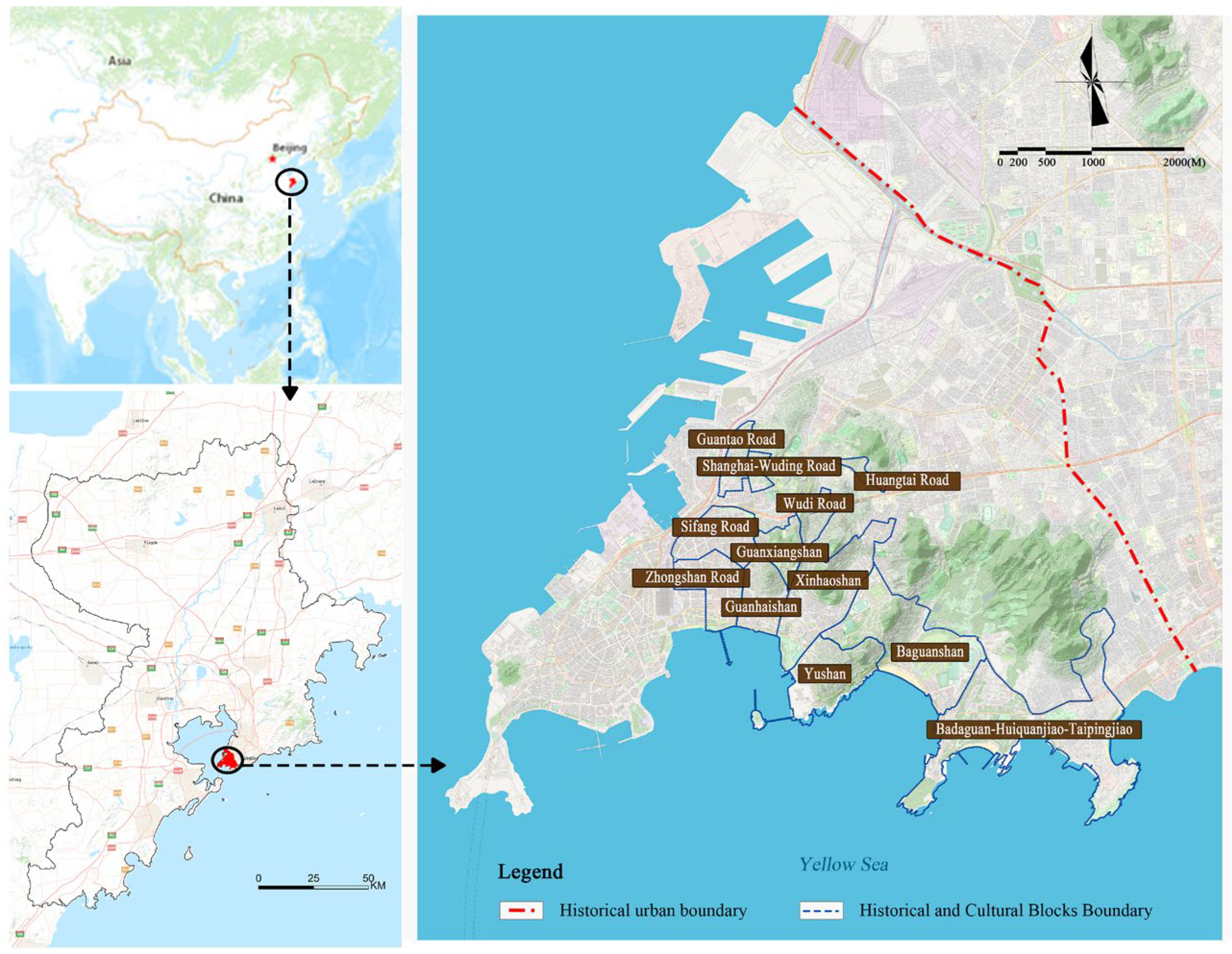

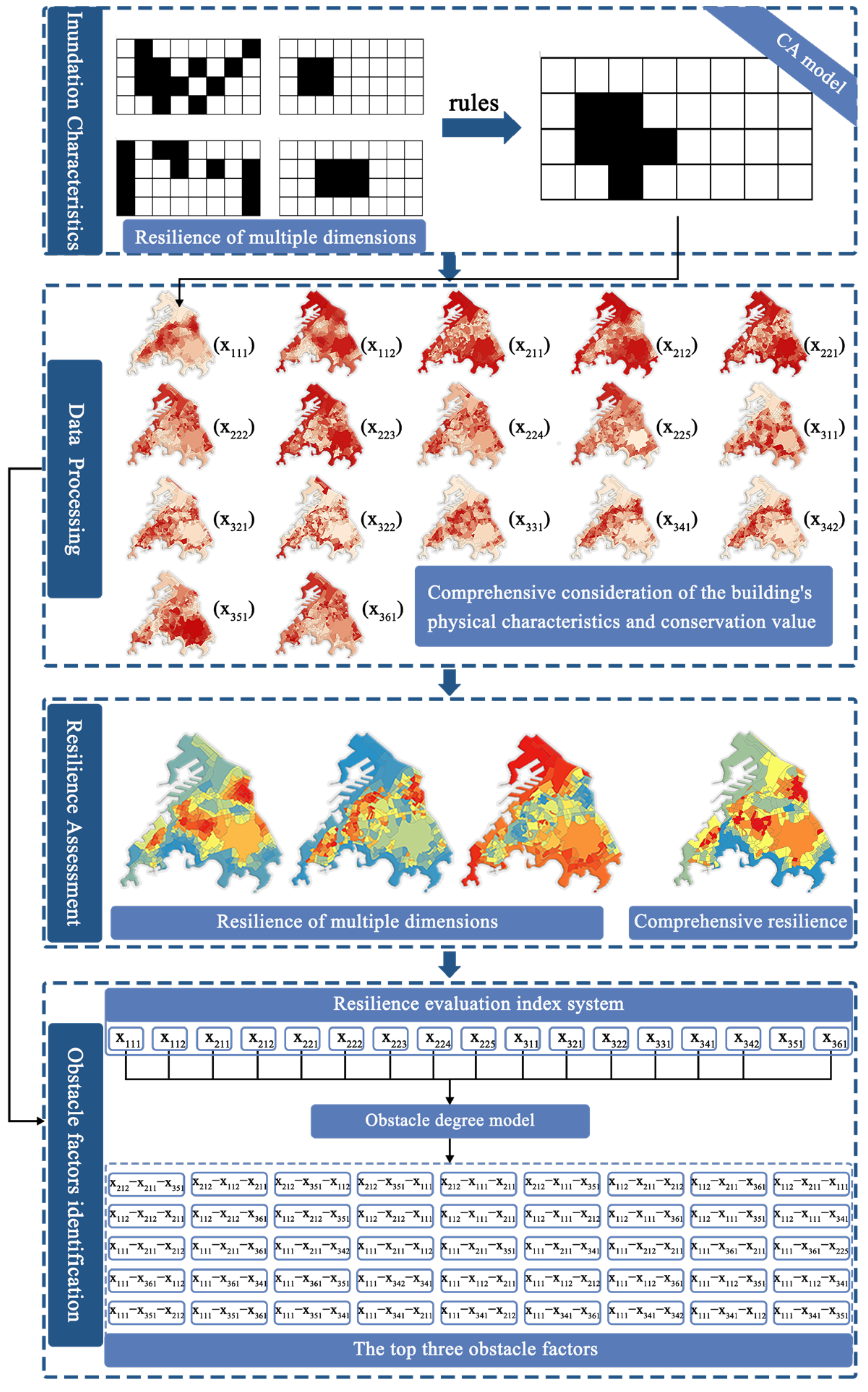

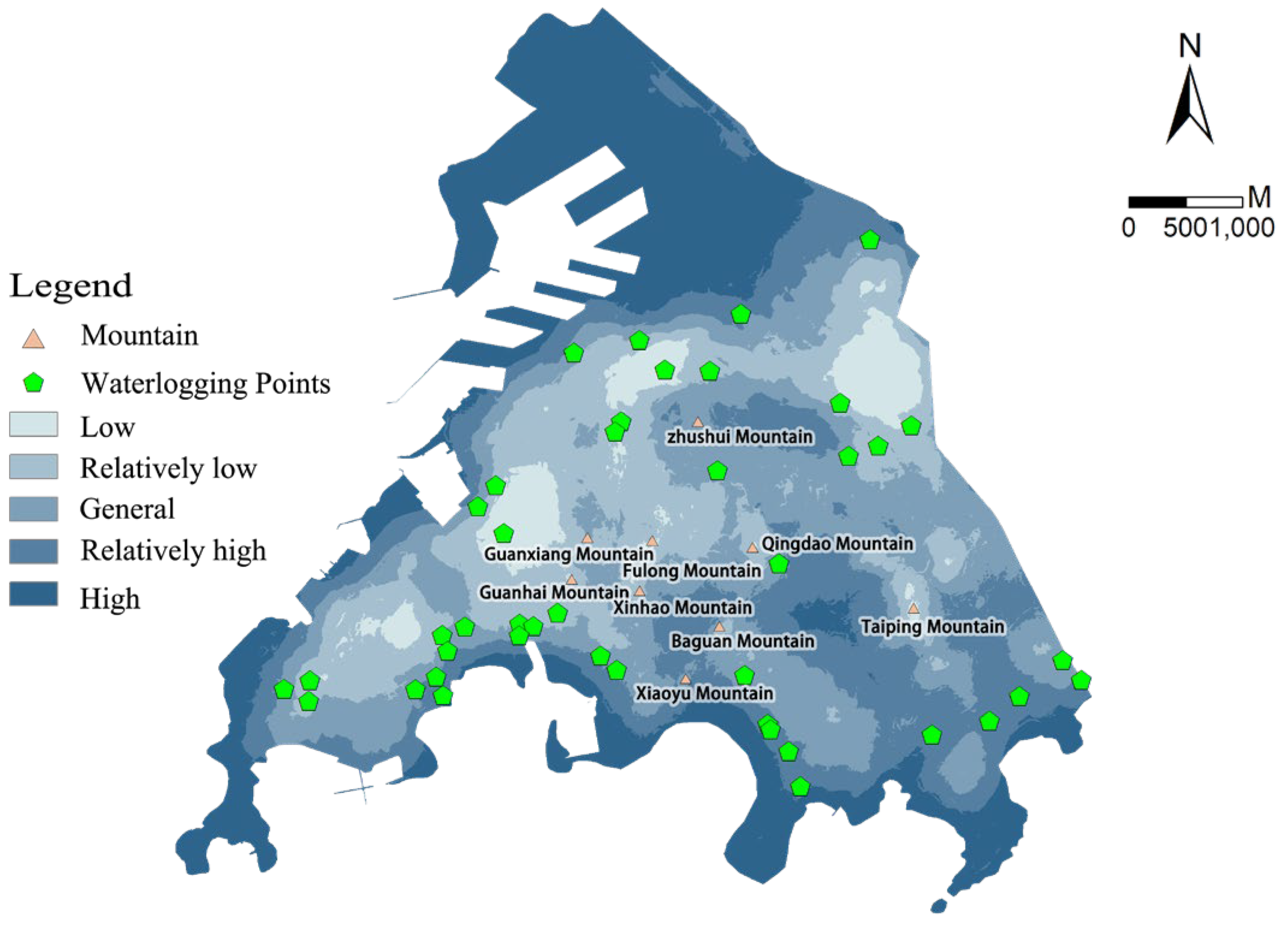

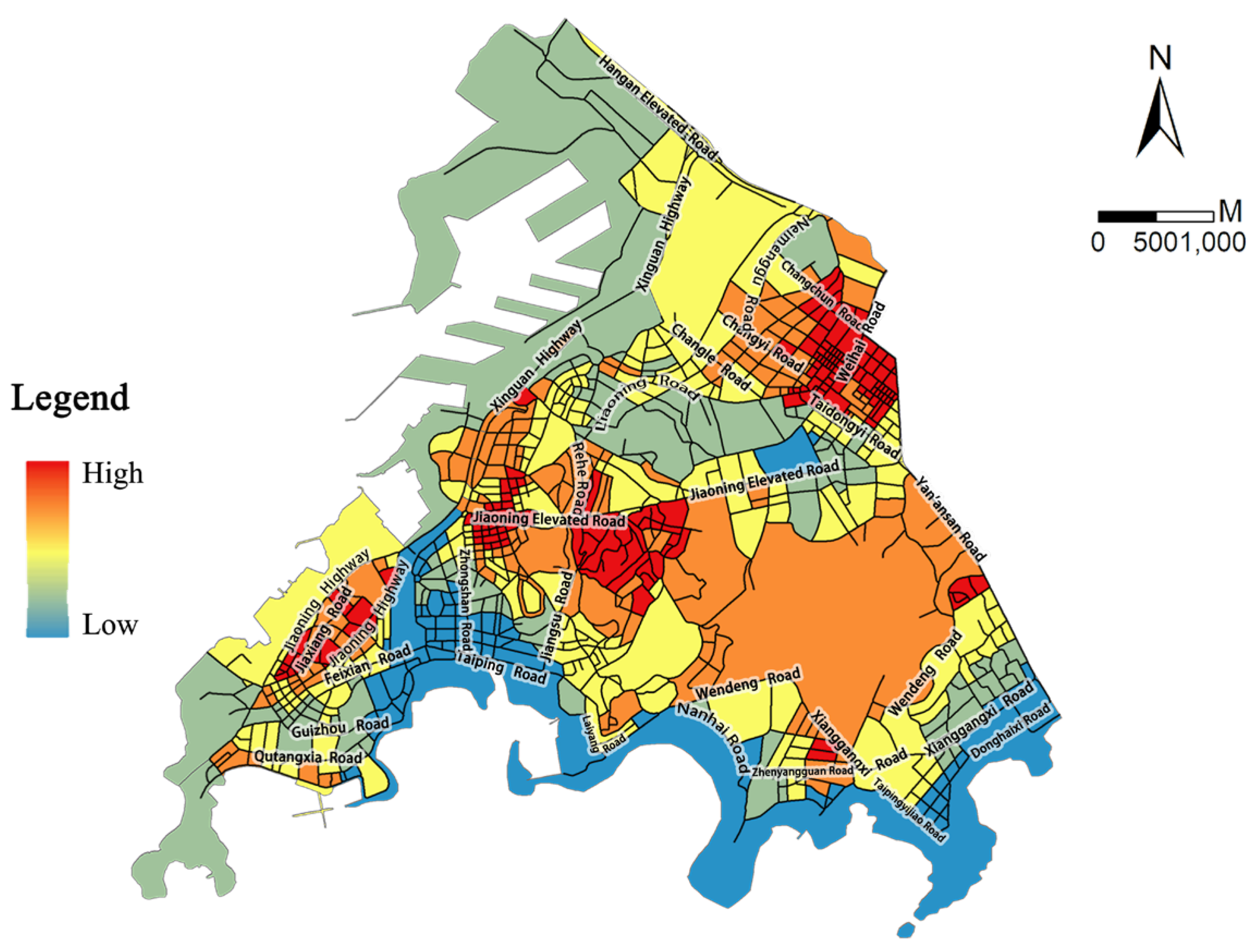
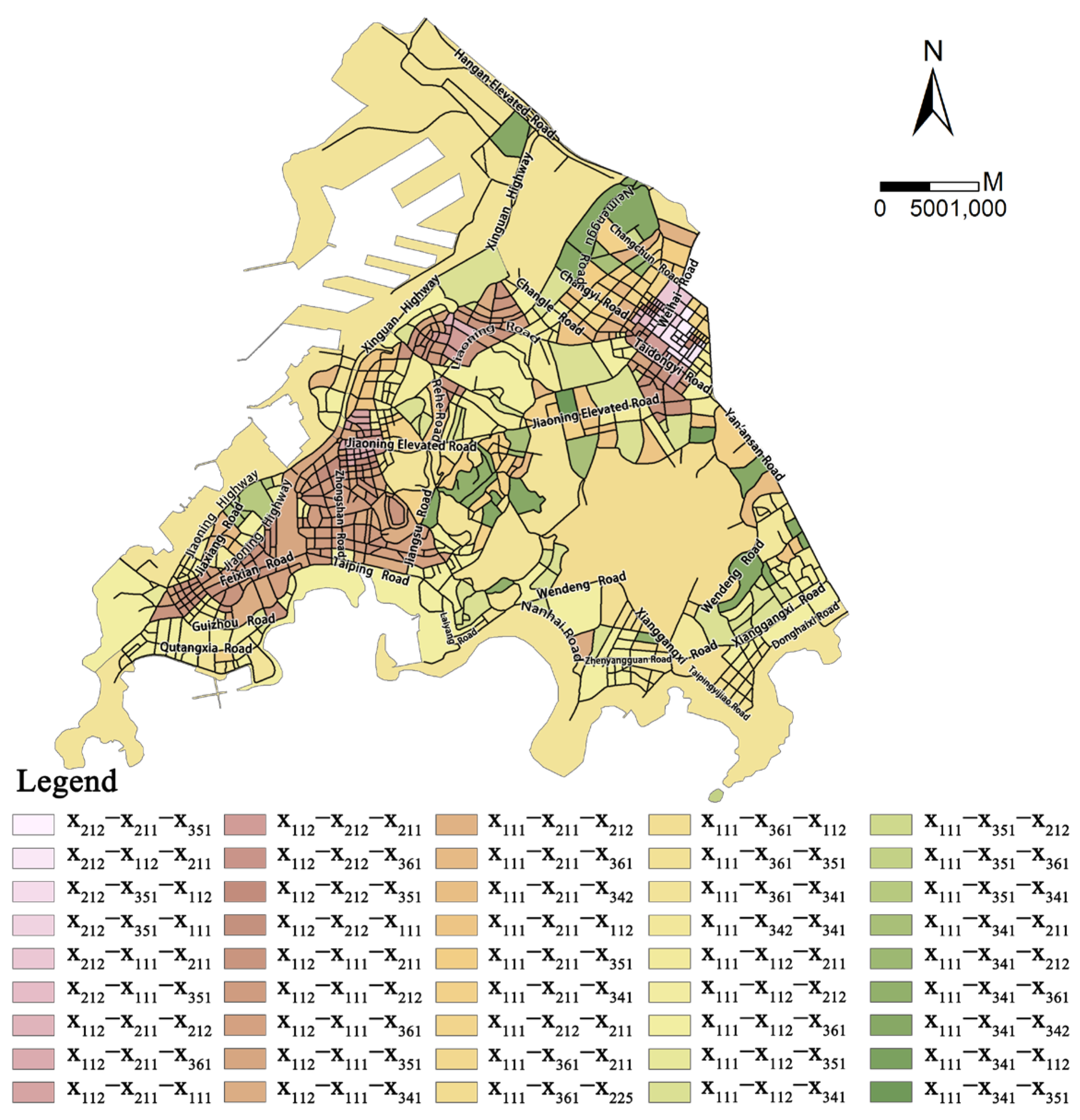
| Data Type | Data Sources | Data Time |
|---|---|---|
| Waterlogging sites | Baidu search engine (http://baidu.com) | 31 December 2023 |
| POI | https://lbs.amap.com/ | 31 December 2023 |
| Drainage network | Qingdao Municipal Bureau of Housing and Urban-Rural Development | 31 December 2023 |
| Building | https://lbs.amap.com/ Qingdao Municipal Bureau of Housing and Urban-Rural Development | 31 December 2023 |
| Road network | https://www.openhistoricalmap.org/ | 31 December 2023 |
| Primary Indicator Layer | Secondary Indicator Layer | Third Indicator Layer | Indicator Type | Weight |
|---|---|---|---|---|
| Dangerousness (x1) | Disaster exposure dangerousness (x11) | Depth of waterlogging (x111) | − | 0.1612 |
| Density of sensitive sites (x112) | − | 0.0315 | ||
| Vulnerability (x2) | Vulnerability of population characteristics (x21) | Population density (x211) | − | 0.0531 |
| Intensity of crowd concentration (x212) | − | 0.0745 | ||
| Built-in characteristic vulnerability (x22) | Building density (x221) | − | 0.1173 | |
| Construction time (x222) | − | 0.0847 | ||
| Building grade (x223) | − | 0.0483 | ||
| Vulnerability of building structures (x224) | − | 0.0568 | ||
| Business Complexity (x225) | − | 0.0796 | ||
| Adaptability (x3) | Shelter infrastructure (x31) | Accessibility of emergency shelters (x311) | + | 0.0411 |
| Traffic level (x32) | Road density (x321) | + | 0.0327 | |
| Road accessibility (x322) | + | 0.0344 | ||
| Medical rescue (x33) | Distance to hospital (x331) | − | 0.0207 | |
| Drainage network characteristics (x34) | Pipeline network node (x341) | + | 0.0253 | |
| Density of pipe network (x342) | + | 0.0247 | ||
| Ecological environment (x35) | NDVI (x351) | + | 0.0347 | |
| Engineering measure (x36) | Building renovation and strengthening (x361) | + | 0.0794 |
| Built Environment Scenarios | Calculation Formula |
|---|---|
| Buildings (including key buildings) | |
| General hardened surfaces | |
| Low-lying hardened surfaces | |
| Hollow ground | |
| Ground | |
| Vegetation and ground | |
| Vegetation and hollow ground | |
| Rainwater well | |
| General hardened surfaces and rainwater well | |
| Low-lying hardened pavement and rainwater well | |
| Hollow ground and rainwater well | |
| Vegetation and rainwater well | |
| Lakes | |
| Vegetation and lakes |
| Waterlogging Resilience Classification | Waterlogging Resilience Index |
|---|---|
| Higher | 0.405381 < Res ≤ 0.472806 |
| High | 0.472807 < Res ≤ 0.525328 |
| Moderate | 0.525329 < Res ≤ 0.564724 |
| Low | 0.564725 < Res ≤ 0.600678 |
| Lower | 0.600679 < Res ≤ 0.663721 |
| Risk Level | Number of Flooded Sites |
|---|---|
| Low | 2 |
| Relatively low | 14 |
| General | 15 |
| Relatively high | 11 |
| High | 0 |
Disclaimer/Publisher’s Note: The statements, opinions and data contained in all publications are solely those of the individual author(s) and contributor(s) and not of MDPI and/or the editor(s). MDPI and/or the editor(s) disclaim responsibility for any injury to people or property resulting from any ideas, methods, instructions or products referred to in the content. |
© 2025 by the authors. Published by MDPI on behalf of the International Society for Photogrammetry and Remote Sensing. Licensee MDPI, Basel, Switzerland. This article is an open access article distributed under the terms and conditions of the Creative Commons Attribution (CC BY) license (https://creativecommons.org/licenses/by/4.0/).
Share and Cite
Cao, F.; Wang, Q.; Qiu, Y.; Wang, X. Comprehensive Assessment and Obstacle Factor Recognition of Waterlogging Disaster Resilience in the Historic Urban Area. ISPRS Int. J. Geo-Inf. 2025, 14, 208. https://doi.org/10.3390/ijgi14060208
Cao F, Wang Q, Qiu Y, Wang X. Comprehensive Assessment and Obstacle Factor Recognition of Waterlogging Disaster Resilience in the Historic Urban Area. ISPRS International Journal of Geo-Information. 2025; 14(6):208. https://doi.org/10.3390/ijgi14060208
Chicago/Turabian StyleCao, Fangjie, Qianxin Wang, Yun Qiu, and Xinzhuo Wang. 2025. "Comprehensive Assessment and Obstacle Factor Recognition of Waterlogging Disaster Resilience in the Historic Urban Area" ISPRS International Journal of Geo-Information 14, no. 6: 208. https://doi.org/10.3390/ijgi14060208
APA StyleCao, F., Wang, Q., Qiu, Y., & Wang, X. (2025). Comprehensive Assessment and Obstacle Factor Recognition of Waterlogging Disaster Resilience in the Historic Urban Area. ISPRS International Journal of Geo-Information, 14(6), 208. https://doi.org/10.3390/ijgi14060208








